Project 43: Black Bear
This black bear lived in an outdoor enclosure at the Arizona Sonora Desert Museum in Tucson, Arizona. I’ve seen wild black bears in the U.S. and Canada, but I have never been able to get a good reference photo in their natural habitat. Eventually, this bear struck a relaxed pose that I wanted to paint.


Reference Photo
Materials
Paints
Burnt Umber
Cadmium Orange
Cadmium Red Medium
Cerulean Blue
Hooker’s Green Permanent
Naples Yellow
Raw Sienna
Titanium White
Ultramarine Blue
Brushes
no. 3 and 10 rounds
no. 5, 6, 8 and 10 brights
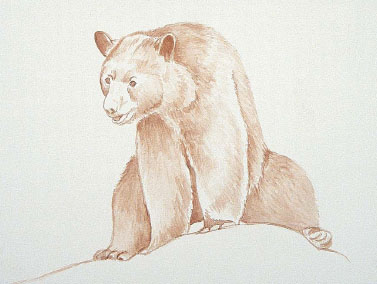
1 Establish the Form
Draw the bear lightly in pencil, using a kneaded eraser for corrections or to lighten lines. With diluted Burnt Umber and a no. 10 round, paint the main lines and the form of the bear.
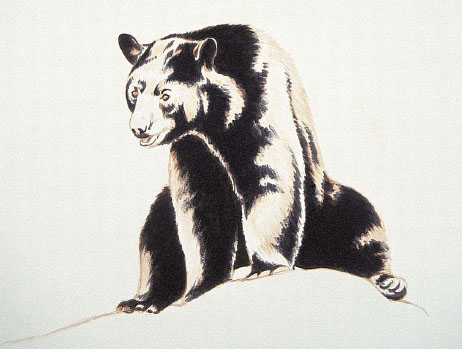
2 Paint the Dark Values
Mix a black fur color for the bear’s coat with Burnt Umber and Ultramarine Blue. Paint the darkest parts of the coat with a no. 10 round, using strokes that follow the fur growth pattern. Switch to a no. 3 round for facial details. For darkest coverage, keep adding layers of paint after the first layer has dried.
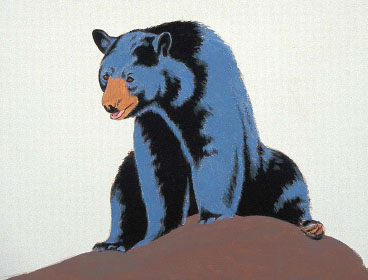
3 Paint the Middle Values
Mix a slate blue fur color with Titanium White, Ultramarine Blue and Burnt Umber. Paint with a no. 10 round. Mix a grayish brown for the rock with Titanium White, Burnt Umber and Ultramarine Blue, and use a no. 10 bright.
Mix tan for the muzzle with Titanium White and Raw Sienna. Paint with a no. 10 round. Mix pink for the tongue with Titanium White, Cadmium Red Medium and Naples Yellow, and paint with a no. 3 round. Mix a lighter pink for the bear’s lip by adding more Titanium White to the mixture.
Mix a brown eye color with Raw Sienna and Burnt Umber. With a no. 3 round, paint the eyes and define the mouth.
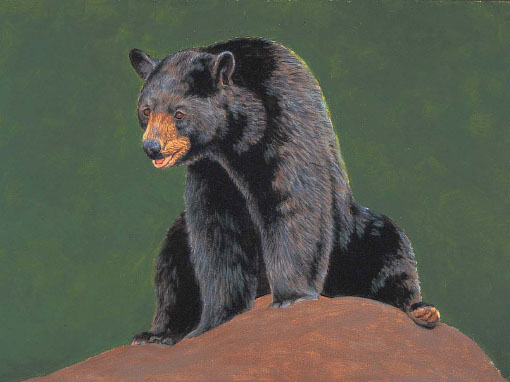
4 Paint the Background Color and Begin to Add Detail
Add warmth to the bear and rock by painting a thin (but not soupy) glaze of Burnt Umber over the entire area with a no. 6 bright. Paint thinly so that the original colors show through the glaze. When dry, add more glazes as needed.
With a no. 10 round and the black fur color, add detail to the lighter areas of the coat using strokes that follow the fur pattern. When adding detail to the muzzle, paint with very light-pressured strokes. Paint the highlighted part of the nose with the slate blue color, blending with the black fur color.
Mix a forest green color with Hooker’s Green Permanent, Burnt Umber, Cerulean Blue and a small amount of Titanium White. To paint the background, use dabbing strokes with a no. 5 bright.
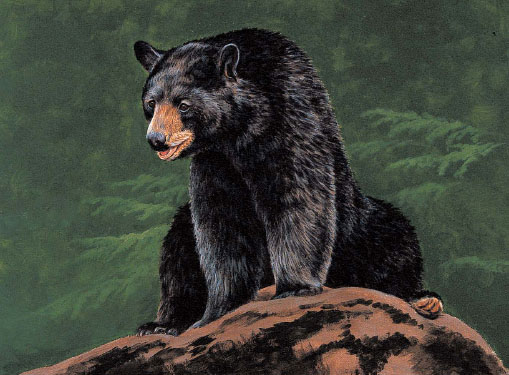
5 Add More Detail
Mix a dark slate blue fur color with a portion of the slate blue fur color, Burnt Umber and Ultramarine Blue. Lightly paint fur detail in the dark areas of the coat with a no. 10 round.
Mix a light highlight color with Titanium White and a touch of the slate blue fur color. Paint highlights in the coat sparingly with a no. 3 round, as well as in the eyes and on the face.
Mix a dark mossy green for the rock with a portion of forest green mixed with Burnt Umber and Ultramarine Blue. Use a no. 6 bright to paint broken, dabbing strokes.
Mix a pine branch color with Hooker’s Green Permanent, Burnt Umber, Titanium White and Naples Yellow. Paint a few sketchy branches in the background using a no. 10 round.

ROCK SITTER
Acrylic on Gessobord
9” × 12” (23cm × 30cm)
6 Paint the Finishing Details
Mix a medium mossy green for the rock with Hooker’s Green Permanent, Naples Yellow, Burnt Umber, Cadmium Orange and a small amount of Ultramarine Blue. Paint with a no. 6 bright, using a clean no. 6 bright for the dark mossy green. Paint with dabbing strokes, roughly blending where the two colors meet.
Mix a moss highlight color with a portion of the medium mossy green, Titanium White and Naples Yellow. Paint highlights with a no. 10 round, blending where the colors meet with separate no. 10 rounds for the medium and dark mossy greens.
Lightly paint some medium mossy green over the highlighted parts of the bear’s coat with a no. 10 round, following the original strokes.
With a no. 8 bright and the dark mossy green, paint darker areas over the background with loose, dabbing strokes. Allow some of the original color to show through in places. Tone down the pine branches with a glaze of diluted dark mossy green.
